 资源简介
资源简介
Unit 5 What are the shirts made of
Section A (1a-1c)
一、教学目标:
1. 语言知识目标:
1) 能掌握以下单词: chopsticks, coin, fork, blouse, silver, glass, cotton,
能掌握以下句型:
① —This ring looks nice. Is it made of silver
—Yes, and it was made in Thailand.
② What is it made of/from
2) 能够用英语描述及询问物品的制作材料,正确理解被动语态的用法及句子结构。
2. 情感态度价值观目标:
了解一些日常用品的制成材料,增加生活常识,养成良好的生活习惯;
二、教学重难点
1) 掌握本课时中出现的生词
2) 能够用英语描述及询问物品的制作材料
三、教学过程
Ⅰ. Presentation
1. Show some pictures on the big screen. Try to learn the new words using “be made of” structure.
Learn the new words: chopsticks, coin, fork, blouse, silver, glass, cotton, steel,
2. Ss discuss with their partner and try to learn the new words.
Ⅱ. Listening
T: Tell Ss they will hear a conversation about some things and material. Listen and match the products with what they are made of and where they were made.
Things Made of Made in
shirts cotton Korea
chopsticks silver Thailand
ring steel America
2. Let one student read the words in the box, Play the recording for the Ss to listen.
3. Ss try to listen and match the things with the material and here they were made.
Ⅲ. Pair work
1. Read the conversation in the box in 1c.
2. Ss try to made conversations using the information in 1b.
e.g. A: This ring looks nice. Is it made of silver
B: Yes, and it was made in Thailand.
Let some pairs read out their conversations.
IV. Summary
V,Homework
完成下列句子。
1) 葡萄酒是葡萄制成的。Grape wine ______________ grapes.
2) 桌子是木材制成的。 The desks ______________ wood.
3) 那张报纸被制成了一顶帽子。 The newspaper was ___________ a hat.
Section A 1 (2a-2d)
一、教学目标:
1. 语言知识目标:
1) 能掌握以下单词: grass, leaf, produce, widely, be known for, process, pack
能掌握以下句型:① All the works at the fair were made by university students.
② What is it made of/from ③ China is famous for tea, right
2) 能够用英语描述及询问物品的制作材料,正确理解被动语态的用法及句子结构。
二、教学重难点
1) 掌握本课时中出现的生词
2) 能够用英语描述及询问物品的制作材料
I Greeting
II Listening
Pre-listening
fair adj. 公平的; 合理的; 美丽的
fair n. an event at which people or businesses show and sell products
Work on 2a:
T: Let’s listen to another conversation between Nick and Marcus.
1. What are they talking about First, let’s look at the pictures and the phrases in 1a.
2. Play the recording for the Ss to listen and check the phrases.
Work on 2b:
1. Let Ss read the sentences below. Explain some main sentences for the Ss. Make sure they know what to do.
Ⅲ. Pair work
1. Tell Ss to make a conversation using the information in 2a and 2b.
2. Let Ss make their own conversations.
IV. Role-play
1. Work on 2d
Task 1 Read the conversation and answer the questions.
1. Which country is famous for tea
2. Where is tea produced in China
3. How are tea leaves picked
V. Language points and Summary
1. What is the model plane made of What is the painting made from
be made of “用……制成, 由……构成” (成品仍可看出原材料)
be made from“用……制成, 由……构成” (成品后看不出原材料)
be made in表示“在……制造”,后接表示地点或时间的词语。如:
The washing machine was made in Qingdao.
be made by表示“由……制造”,后接动作的执行者。如:
Was the model plane made by your brother
be made into表示“(原材料)被制成……”。 如:
Glass can be made into bottles.
2. For example, Anxi and Hangzhou are widely known for their tea.
widely adv. 广泛地;普遍地
wide (形容词) + ly → widely (副词)
e.g. Gas is widely used for cooking and heating.
天然气被广泛地用于做饭和取暖。
3. be known for 以……闻名;为人知晓
be known for = be famous for
be known as和be known for辨析
be known as意为“作为……而著名”be known for意为“因……而著名”
1) Han Han ____________ his writings.
2) As we know, Yao Ming __________ a basketball player.
3. Where is tea produced in China
produce v. 生产;制造;出产
英语中有produce, grow和plant三个动词均可用来描述农作物及植物的“种植;
生产;生长”,但有所区别。
produce指农作物成产量化地“出产”,或自然地“生长出;长出;结出(果实)”。
e.g. This region produces over 50% of the country’s rice.
这个地区出产整个国家50%以上的大米。
grow表示“种植;使生长”,着重指种植以后的栽培、生长过程。
4. …, they are picked by hand and then are sent for processing.
VI . Exercises
Ⅰ. 根据语境及所给汉语提示,写出所缺单词。
1. That factory _________(生产) 1,000 bikes last month.
2. _________(棉花) can be made into cloth (布) and many other things.
3. The bowl on show is made of _________(银).
4. The giraffes like eating _________(叶子) and grass.
5. Maria bought two beautiful _________(短上衣) in the shopping mall.
6. There is a glass box under the table, with some _________(硬币) in it.
.
Homework
1. Preview the new words and expressions.
2. Preview the passage The Difficult Search for American Products in the US on page 35.
Section A (3a-3c)
一、教学目标:
1. 语言知识目标:
1) 学习掌握下列词汇:France, no matter, local, brand, avoid, product, handbag,
mobile, everyday
2)阅读短文,能按要求找到相应的信息。
二、教学重难点
1) 掌握本部分出现的生词和词组,达到熟练运用的目标。
2) 阅读短文,获得相关的信息。通过阅读练习,来提高阅读能力。
三、教学过程
Ⅰ. Revision
1. Check the homework.
2. Ask Ss to role-play the conversation in 1b.
A: What do you think of …
B: I think it’s very …
Ⅱ. Presentation
product n. 产品,制品France 法国 handbag n. 小手提包
French adj. 法国的,法国人n. 法语,法国人
III. Warming up
IV. Post reading
What is the key sentence for the passage
Which is the most important key word in the title
Why do you think so
Ask Ss to fill in the blanks to complete the passage.
VI. Language points
1. No matter what you may buy, you might think those products were made in those countries.
无论你买什么, 你也许会认为那些产品一定就是那些国家制造的。
句中的No matter what 表示“无论什么”,引导让步状语从句,它相当于Whatever。
【运用】完成句子
(1) 不管谁来都别开门。
Don't open the door _________________ comes.
2. He found it interesting that so many products in the local shops were made in China.
find it + adj. + to do sth.
发现做某事是……
e.g. 我发现学英语很有趣。(翻译) I find it interesting to learn English.
句中it是形式宾语,that引导的从句是真正的宾语。
3. He realized that Americans can hardly avoid buying products made in China.
他意识到美国人几乎无法避免购买中国制造的产品。
avoid v. 避免;回避
avoid doing sth. 避免做某事
avoid 后面常跟名词、代词或动词ing形式作宾语,但不能跟不定式作宾语。
e.g. They tried to avoid making Mrs. Li angry.
他们尽量避免让李老师生气。。
Ⅶ. Summary
no matter 不论;无论
in the local shops 在当地的商店里
even though 即使;虽然
in fact 确切地说;事实上;实际上
句型
1. No matter what you may buy, you might think those products were made in those countries.
2. Kang Jian thinks it’s great that China is so good at making these everyday things.
Ⅷ. Exercises
1. 尽管昨天天气炎热,Dale还是得外出。 (even though)
___________________________________________
2. 孩子们应该避免长时间看电视。 (avoid)
___________________________________________
Ⅸ. Homework
1. Make sentences with these words: no matter, be made in, find it + adj. that…,
even though, avoid doing sth., everyday things.
Section A (Grammar Focus-4c)
一、教学目标:
1) 学习掌握下列词汇:boss, Germany, surface, material, traffic, postman, cap, glove
2) 进行一步复习巩固学习Section A 部分所学的生词和词组。
二、教学重难点
1) 复习巩固Section A 部分所学的生词和词组,达到熟练运用的目标。
2) 被动语态的用法。
三、教学过程
Ⅰ. Warming up and revision
1. Have a dictation of the new words learned in the last class.
2. Review some main phrases we learned in the last class. Check the homework.
Ⅱ. Grammar Focus
1. 学生阅读Grammar Focus中的句子,然后做填空练习。
① 你的衬衫是棉的吗?
____ your shirts ____ ____ cotton
② 是的,而且它们产于美国。
Yes. And they were _____ ___ the US.
Ⅲ. Summary
被动语态
语态用来表示主语和谓语之间的关系。英语中有两种语态,一种是主动语态,表示主语是动作的执行者;另一种是被动语态,表示主语是动作的承受者。
1. Kelly cleans the house every day. (该句为主动语态,主语Kelly是动作clean的执行者,宾语the house是动作clean的承受者。)
2. The house is cleaned by Kelly every day. (该句为被动语态,主语the house是动作clean的承受者,动作的执行者Kelly由介词by引出。)
被动语态通常由“助动词be+及物动词的过去分词”构成。当我们不知道谁是动作的执行者,或者没有必要指出谁是动作的执行者,或者只需强调动作的承受者时,要用被动语态。如:
English is spoken in many countries.
Such books were written for middle school students.
The computer should be turned off at once.
被动语态可用于多种时态,本单元我们学习一般现在时的被动语态。
一、构成
be (am / is / are) +及物动词的过去分词
如:
The students are told to study hard.
The students aren't told to study hard.
—Are the students told to study hard
—Yes, they are. / No, they aren't.
Who are told to study hard
1. Nowadays China ____ for its new “four great inventions”—shared bicycle, electronic payment, high-speed railways and online shopping. (2018 云南曲靖)
A. was knowing B. was known
C. is knowing D. is known
2. —Your hometown is beautiful, and the air is really fresh.
—Yes. Many trees and flowers ______ around here every year. (2018 广西梧州)
A. plant B. are planted
C. was planted D. will plant
3. The latest mobile phone _______ in China. (2018 江苏徐州)
A. will make B. has made
C. is making D. is made
IV. Practice
1. Work on 4a:
Tell Ss to read the sentences in 4a and try to fill in the blanks with the correct forms of the verbs in brackets.
Ⅷ. Homework
1. Finish the exercises in the workbook.
2. Preview Section B 1a-1e on page 37.
Section B 1 (1a-1e)
一、教学目标:
能掌握以下单词:international, competitor
二、教学重难点
1) 掌握本课时出现的生词及用法。
2) 进行听力训练,提高综合听说能力。
三、教学过程
I. Revision
1. Daily greeting.
2. Review. 主动语态变被动语态的方法
Computers are used to search information.
The story is often repeated by the teacher.
II. Presentation
1. Present the new words on the big screen and learn the new words together.
international adj. 国际的
e.g. The kilogram is the international standard of weight.
公斤是国际通用的重量标准。
national adj. 国家的,民族的
competitor n. 参赛者;竞争者
compete (动词)+ or → competitor (名词)
e.g. We can compete with the best teams.
我们能与最好的队竞争。
III. Warming up
Do you know something about Wei Fang International Kite Festival.
Do you like flying kites
IV. Listing
Work on 1a
1. Do you know how to fly a kite What are kites made of Write down some materials used in making kites.
2. Let Ss discuss about it. Then write down their answers.
V. Listening
1. Tell Ss to listen to a conversation between Laura and Zheng Yun and circle the correct answers.
2. Play the recording for the Ss. Ss just listen for the first time. Play the recording again and circle the correct answers.
VI. Role-play
1. Work in pairs. Role-play a conversation between Laura and Zheng Yun using the information in 1b - 1d.
Ⅶ. Summary
fly a kite 放风筝
an international kite festival 国际风筝节
go on a vacation to ... 去……度假
Ⅸ. Homework
1. Preview the new words and expressions.
2. Preview the article Beauty in Common Things on page 38.
Section B (2a-2e)
一、教学目标:
1) 能掌握以下单词:its, form, clay, balloon, scissors, lively, fairy, heat, polish, complete
2) 能掌握以下句型:
① They are made of bamboo and covered with paper.
② According to Chinese history, sky lanterns were first used by Zhuge Kongming.
③ They are seen as bright symbols of happiness and good wishes.
④ After drying, they are fired at a very high heat.
二、教学重难点
1) 掌握本课时出现的生词及用法。
2) 阅读短文,获得相关信息,提高学生们的综合阅读能力。
三、教学过程
I. Revision
1. Daily greeting.
2. Role-play a conversation.
A: Where did you go on vacation
B: I went to an international kite festival.
II. Presentation
1. Present the new words on the big screen and learn the new words together.
clay n. 黏土;陶土 balloon n. 气球
scissors n. 剪刀 fairy tale 童话故事
paper cutting 剪纸 celebration n. 庆典;庆祝活动
form n. 形式;类型
e.g. Jogging is a healthy form of exercise.
慢跑是一种健康的锻炼方式。
lively v. 生气勃勃的;鲜艳的
e.g. Mary is a lovely young woman with imagination.
玛丽是一名富有想像力生气勃勃的年轻女人。
historical adj. (有关)历史的
e.g. These are not just historical points.
heat n. 热;高温 v. 加热;变热
e.g. Heat the water, otherwise it will freeze. (动词)
把水加热,否则会结冰。
polish v. 磨光;修改;润色
e.g. Let’s polish the silver before the guests arrive.
让我们在客人到达前将银器擦亮。
III. Warming up
What do you know about folk or traditional art, like paper cutting Tell your partner about it.
Ⅳ. Reading
Tell Ss the following is about three kinds of Chinese traditional arts.
Fast Reading:
Careful Reading
1. Let one student read the phrases in the box and translate them into Chinese.
such as turn…into send out
cover with rise into put…on
Ⅴ. Group work
1. Now let’s work on 2e. First read the questions below. Then try to discuss the questions in your group.
Which art form do you think is the easiest Which is the most difficult?Why?
Ⅵ. Language points
1. These usually try to show the things that are important in life, such as love, beauty and family.
such as和for example都有“例如”的意思,但是它们的用法有所不同。
★ such as常用来列举同类人或事物中的多个例子。
e.g. I like animals, such as dogs, cats and monkeys.
我喜欢动物,如狗、猫和猴子。
★ for example一般只以同类人或事物中的“一个”为例。
2. The most common things, from paper to clay to bamboo, are turned into
objects of beauty.
1) turn…into…表示“把……变成……;使……变成……” ,而turn into表示“转变;变成”等意思。e.g. Can you turn an egg into a flower
3. According to Chinese history, sky lanterns were first used by Zhuge Kongming.
according to 根据,按照; 据……所说
辨析有关be used ... 的表达
be used by… 被……使用 be used as… 被当做……用
be used to do 被用来做…… be used to doing… 习惯于做……
4. The pieces are carefully shaped by hand from a very special kind of clay and then allowed to air-dry.
1) 此句中名词piece意为“作品”,指由艺人、作家等创作出来的艺术品或
文学作品。如:
Just take a look at this lovely clay piece. Doesn’t this boy look real!
看看这个可爱的小陶人,这男孩看上去多么逼真啊!
2) by hand 手工 (介词短语)
e.g. The stone was carved by hand.
这块石头是手工雕刻的。
3) air-dry 是由air和dry复合而成的一个合成动词,意为“晾干”,类似的词还有blow-dry吹干。
Ⅶ. Summary
special forms of traditional art
特别的传统艺术形式
turn ... into ... 把……变成……
according to 根据 sky lanterns 孔明灯send ... out 发送……
in trouble 处于困境;遇到麻烦be covered with ... 被 / 用……覆盖
rise into the air 升入空中hot-air balloons 热气球
symbols of happiness and good wishes幸福和美好愿望的象征
be used for doing sth.(=be used to do sth.) 被用来做某事
句型
1. They are seen as bright symbols of happiness and good wishes.
2. Paper cutting has been around for over 1,500 years.
Ⅸ.Homework
1. Read the passage again after school.
2. Try to write a short introduction on how to make a Chinese clay piece.
Section B (3a-Self Check)
一、教学目标:
1. 语言知识目标:
1) 复习被动语态的不同用法。
2) 能够用英语描述一些常用生活用品的制作材料;描述一些熟悉物品的制作过程。
3) 能用就本单元所学习的语法知识及语言材料,就自己所熟悉的话题写一篇小作文。
介绍自己家乡的某个较为著名的艺术品、食物、工商产品等。
2.情感态度价值观目标:
了解一些日常用品的制成材料,增加生活常识,养成良好的生活习惯;了解一些地方知名产品或传统艺术品的制作过程以及制作材料,培养学生的民族自豪感及爱国主义精神。
二、教学重难点
1. 教学重点:
1) 能运用本单元所学的语法及语言材料,完成写作介绍自己熟悉的物品的制件材料及过程。
2)掌握本单元所学被动语态这一语法知识点,并能运用这一知识进行造句。
3)能总结本单元所学的物质材料、及一些艺术品的简单制作过程。
2. 教学难点:
阅读短文,完成写作。
三、教学过程
Learning objectives
1. To write a passage about a special thing that your town is famous for.
2. To finish Self Check.
Ⅰ. Revision
Review the main phrases and sentences.
Ⅱ. Discussion
Talk about some special things that your city is famous for.
Ⅲ. Writing
1. Work on 3a.
What are some special things that your town/ city is famous for These can be food, artwork or any other products. Discuss them with a partner and take notes.
2. Work on 3b.
Write a paragraph about the product. Use your notes in 3a.
Use the following expressions to help you:
My town/city is famous for…
…is famous in my town/ city.
…is / are made of/ from/ with/ by/ in…
…is / are used for…
…is / are known for…
…is / are special because…
【写作任务】
假如你叫李华,来自江西省景德镇市。近日,你的加拿大笔友Marcus发来一封电子邮件,他说要来你市旅游,询问你市以什么而闻名,并让你推荐可以赠送朋友的纪念品。请你根据下面的要点提示给他回复邮件。
要点提示:1. 以瓷器(china)闻名及其意义; 2. 原材料:陶土; 3. 用途:可供人们欣赏、也可用来装(contain)东西;4. 最佳推荐:青花瓷(blue and white porcelain)。
【思路点拨】
1. 定基调
体裁:应用文(邮件);邮件的主体部分为说明文 时态:介绍事物时用一般现在时 人称:第三人称
2. 谋布局、写句子
3. 巧衔接
第一次提到“瓷器”时用china,再次提到时可以用it代替;为了避免重复,句(6)中的in my city在成篇章时可以用here来代替,这都是使用照应手段来使文章衔接的方法。在衔接瓷器的两个意义和两个用途时可以使用表示并列关系的词and;在陈述瓷器很特别的理由时可以使用表示原因的词because,这是使用逻辑纽带的方式使文章衔接的方法。
4. 添佳句
It is known to people around the world.
(它被全世界的人们所熟知。)
5. 成篇章
Dear Marcus,
How are you doing these days I'm excited to hear from you. I'd like to introduce something special in my city to you.
_______________________________________________________________
Welcome to my city! I hope you will have a good time here!
Best wishes!
Yours,
Li Hua
2. 谋布局、写句子
(1) is known / famous / well-known for its china
(2) China is a symbol of traditional Chinese culture
(3) China is made from clay
(4) China is made to be enjoyed by people
(5) China is used for containing things
(6) Every day many different kinds of china are produced / made
5. 成篇章
Dear Marcus,
How are you doing these days I’m excited to hear from you. I’d like to introduce something special in my city to you.
My city, Jingdezhen in Jiangxi Province, is famous for its china. China is special because it is an example of exquisite Chinese craftsmanship and it is a symbol of traditional Chinese culture. It is made from clay. It is made to be enjoyed by people.And it is used for containing things. Many things are made of china in our everyday life, such as cups, bowls and plates. Every day many different kinds of china are produced here. Blue and white porcelain is the most famous one. It is known to people around the world. You can buy some for your friends and relatives.
Welcome to my city! I hope you will have a good time here!
Best wishes!
Yours,
Li Hua
Ⅳ. Self Check
Work on Self Check 1.
1. List some things you use every day. Write down what they are made of/from and where they were made
2. Let Ss discuss with their partners. Try to fill in the blanks.
If necessary, Ss can review the things in Section A and B.
Work on Self Check 2.
1. Tell Ss to make true sentences with the information in Self check 1.
2. Give Ss one example:
My pencil is made of wood and it was made in Shanghai.
Ss try to make their own sentences.
3. Exchange their sentences and check if there’s any mistake.
Work on Self Check 3.
Make sure Ss know what they should do.
T: Complete the sentences using the correct forms of the words in brackets.
Ⅴ. Exercise
Ⅵ.Homework
1. Finish the exercises in the workbook.
2. Preview the new words and expressions in Unit 6.
3. Preview 1a-2d on P41-42.
教后记
PAGE
展开更多......
收起↑
 资源预览
资源预览
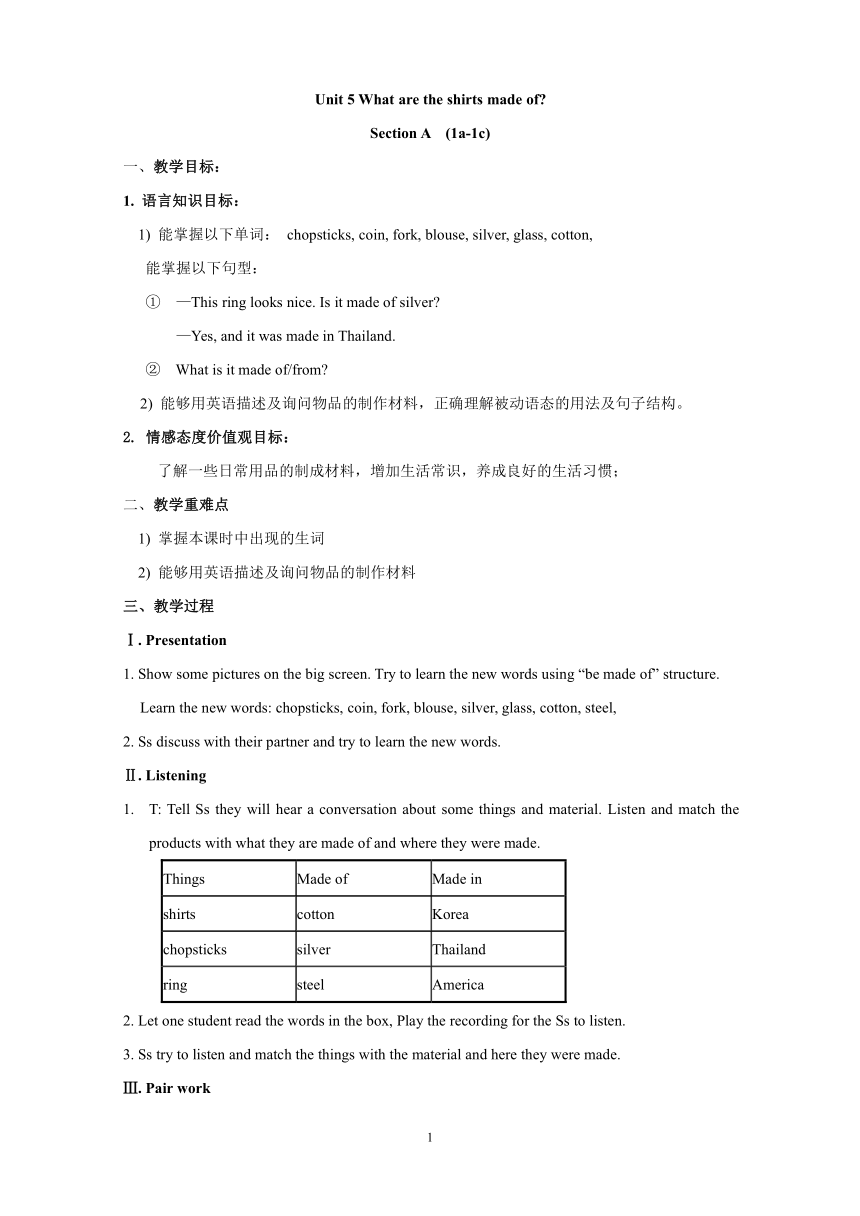
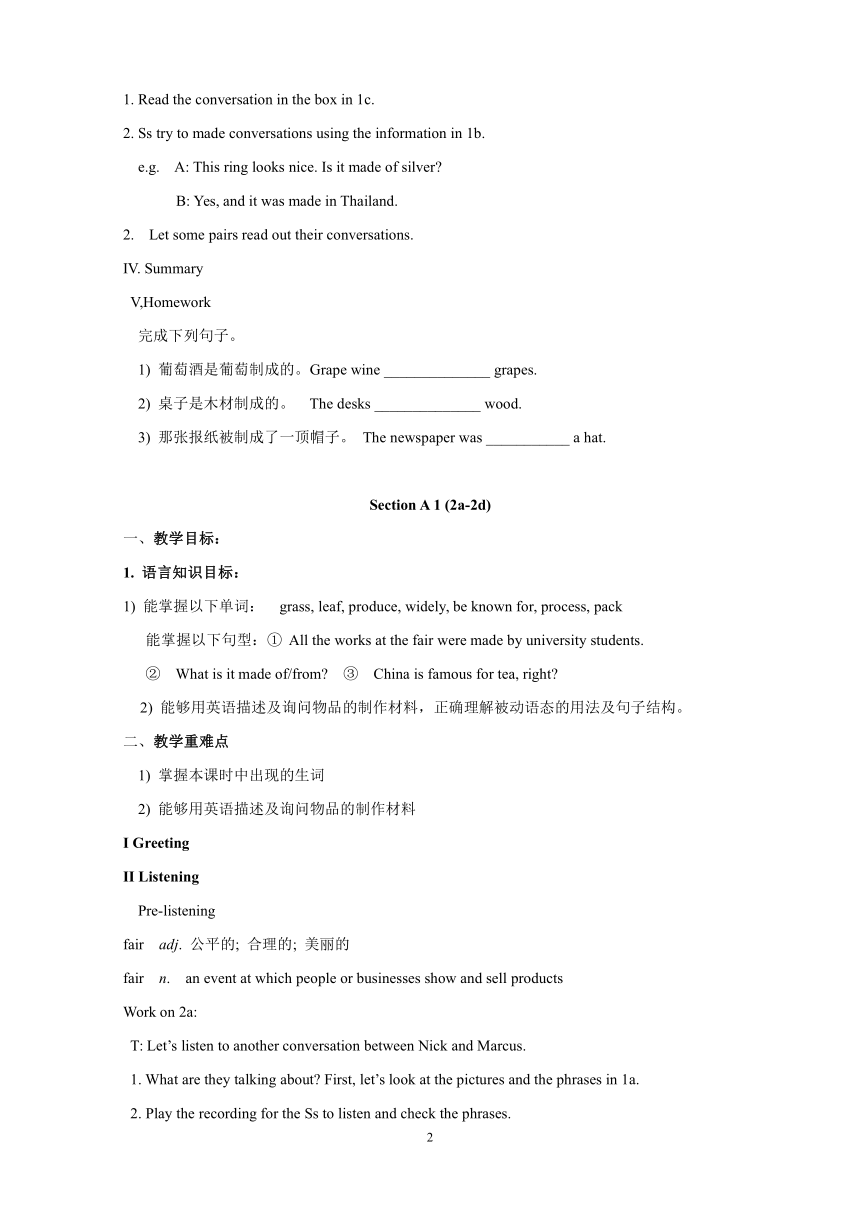
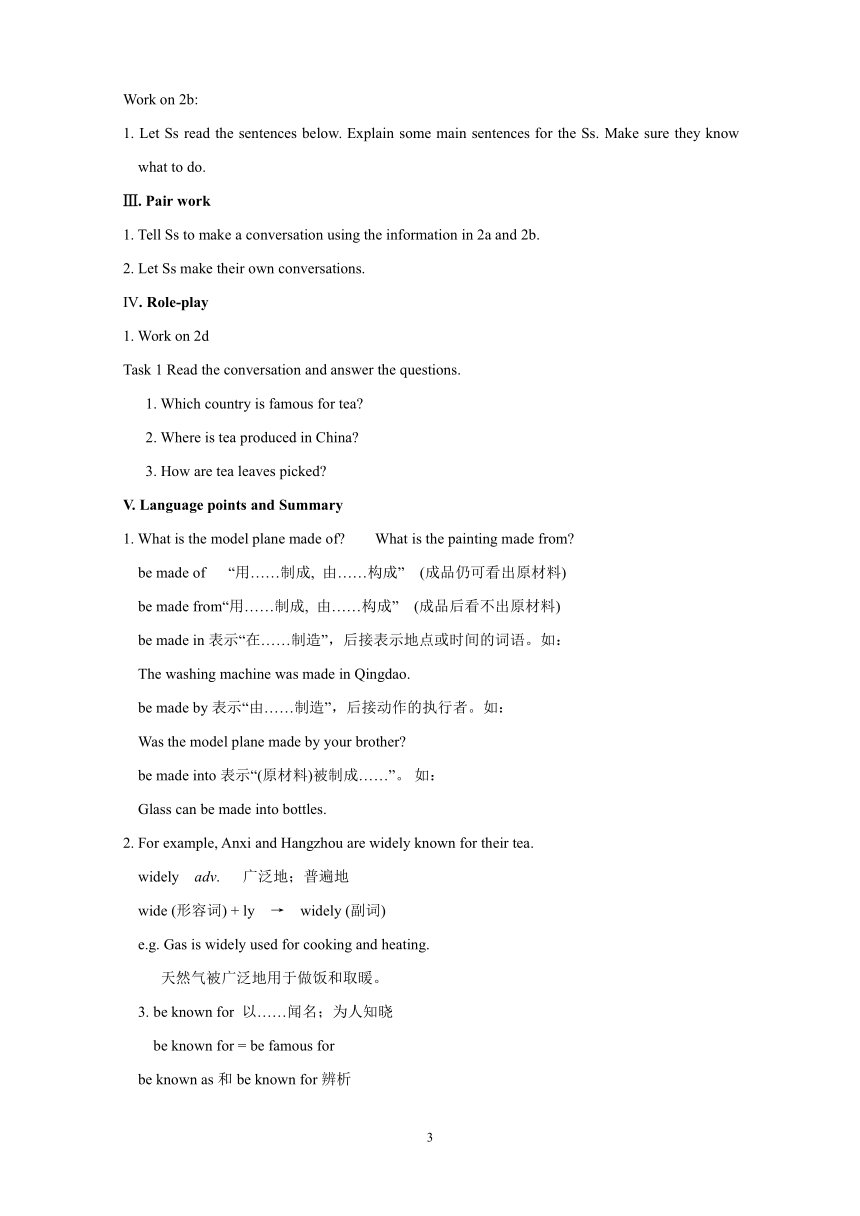
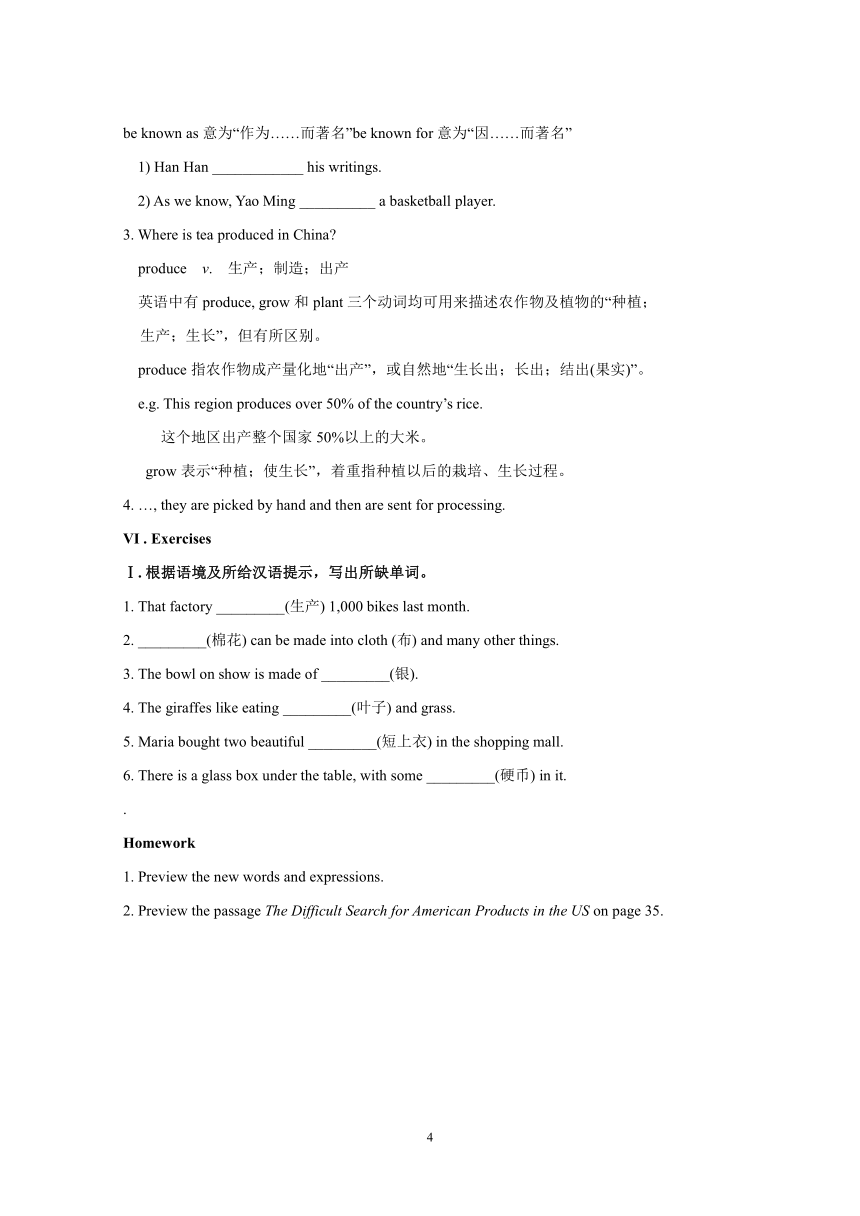
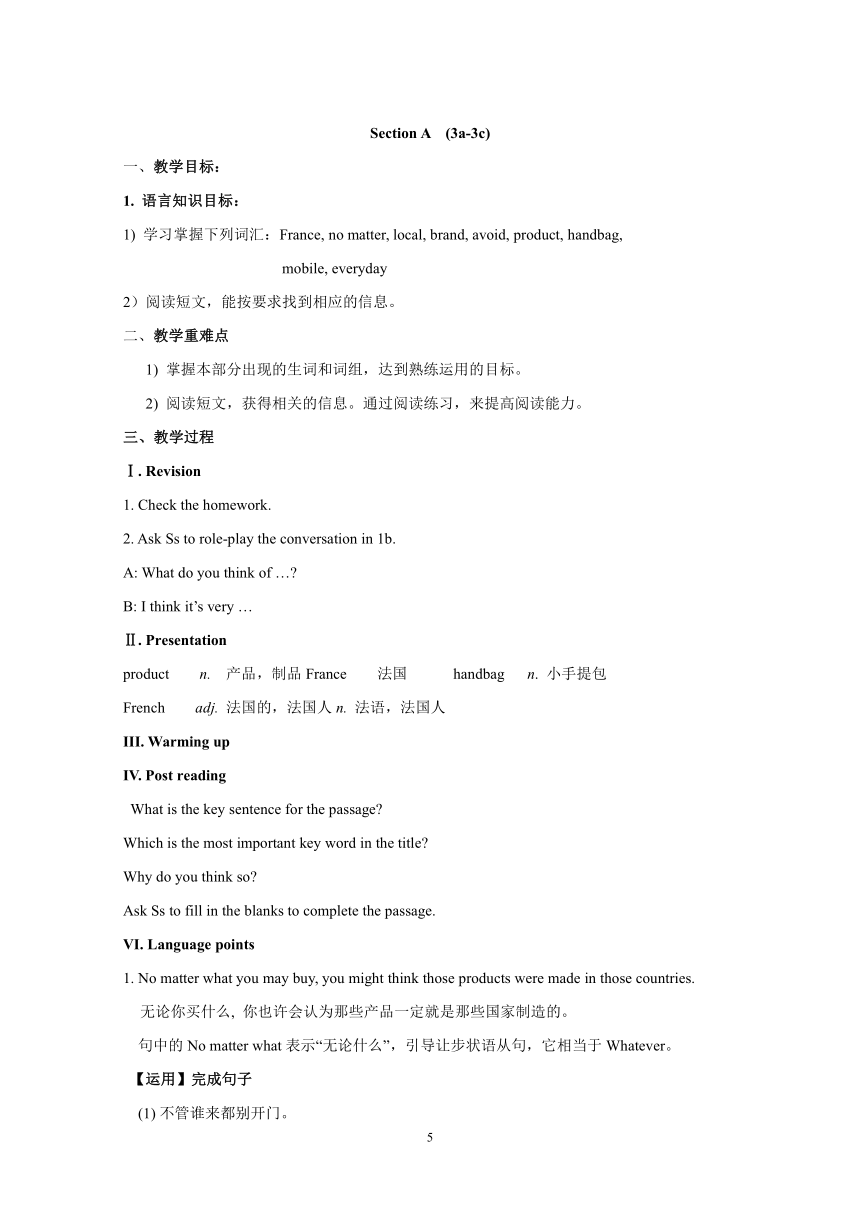
 资源预览
资源预览




